Abstract
CAP-1 is a cuticle peptide isolated from the acid-insoluble fraction of the exoskeleton of the crayfish Procambarus clarkii. CAP-1 is an acidic peptide and comprises 78 amino acid residues. The C-terminal part is especially highly acidic by a phosphoserine and an Asprepeat, which is thought to be responsible for the calcification inhibitory activity in vitro. To examine the significance of the Asp-repeat and to get information on structure-activity relationship, various small related peptides with different sequences were synthesized and tested for the inhibitory activity. The results showed that 1) the activity depends not on the Asp-containing sequence but on the total number of Asp residues, 2) peptide conformation does not affect the activity, and 3) Asp is more effective in inhibitory activity than Glu. These characteristics seem to be consistent with the fact that acidic matrix proteins identified so far from various biominerals have almost no sequence similarity, leading to the idea that the molecular evolution of matrix proteins and peptides in biominerals might be intrinsically different from that of enzymes, hormones and other important functional proteins possibly due to the difference in the mode of interaction between proteins and inorganic compounds, or between proteins and organic compounds.
Similar content being viewed by others
References
Weiner S, Addadi L. Acidic macromolecules of mineralized tissues: the controls of crystal formation. Trends in Biochemical Sciences, 1991, 16: 252–257
Inoue H, Ozaki N, Nagasawa H. Purification and structural determination of a phosphorylated peptide with anti-calcification and chitin-binding activities in the exoskeleton of the crayfish. Procambarus clarkii. Bioscience Biotechnology Biochemistry, 2001, 65: 1840–1848
Inoue H, Ohira T, Ozaki N, et al. Cloning and expression of a cDNA encoding a matrix peptide associated with calcification in the exoskeleton of the crayfish. Comparative Biochemistry and Physiology, 2003, B136: 755–765
Inoue H, Ohira T, Nagasawa H. Significance of the N- and C-terminal regions of CAP-1, a cuticle calcification-associated peptide from the exoskeleton of the crayfish, for calcification. Peptides, 2007, 28: 566–573
Wheeler A P, George J W, Evans C A. Control of calcium carbonate nucleation and crystal growth by soluble matrix of oyster shell. Science, 1981, 212: 1397–1398
Nagasawa H. Macromolecules in biominerals of aquatic organisms. Thalassas, 2004, 20: 15–24
Samata T. Recent advances in studies on nacreous layer biomineralization. Molecular and cellular aspects. Thalassas, 2004, 20: 25–44
Author information
Authors and Affiliations
Corresponding author
Rights and permissions
About this article
Cite this article
Sugisaka, A., Inoue, H. & Nagasawa, H. Structure-activity relationship of CAP-1, a cuticle peptide of the crayfish Procambarus clarkii, in terms of calcification inhibitory activity. Front. Mater. Sci. China 3, 183–186 (2009). https://doi.org/10.1007/s11706-009-0028-x
Received:
Accepted:
Published:
Issue Date:
DOI: https://doi.org/10.1007/s11706-009-0028-x




